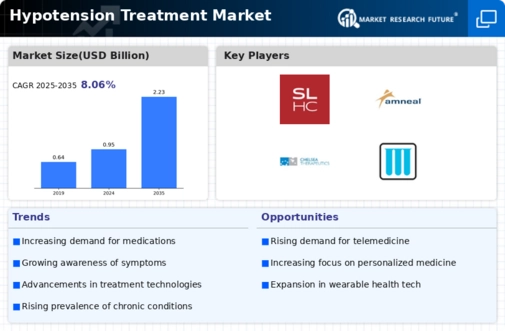Market Trends
Key Emerging Trends in the Hypotension Treatment Market
The turnover of hypotension treatment market is a reflection of a dynamic landscape impacted by evolving healthcare paradigms and advancing medical technologies. Innovations and options for treating hypotension, which is identified by abnormally low blood pressure, have escalated in the last few years. The personalization concept has shown to be one major trend in this field where treatments are tailored towards the characteristics of individual patients. With developments in genetic testing and biomarker research, health professionals are increasingly adopting targeted therapies that address the specific underlying causes of hypotension.
Pharmaceutical players influence market trends by developing new medications to cure hypotension. Introduction of novel drugs with reduced side effects and better efficacy has reshaped how treatment works. Another shift towards combination therapy has become an option in managing different aspects of hypotension through several medication prescriptions. It also focuses on reducing untoward effects while ensuring that patients have full treatment services.
Integration of technology into hypotension management is another significant market trend. Real-time monitoring and control over blood pressure levels using digital health solutions such as wearable devices and mobile applications are increasingly popular today.Because patients can actively take part into their care via these gadgets it means that patient centered care is gaining traction. Remote patient monitoring as well as telehealth services are on the rise making it convenient for people to manage their conditions at home thus lessening the burden on healthcare infrastructure.
Non-pharmacological interventions represent an emerging trend within the market for hypotension treatment. Recognizing dietary habits changes, exercise regimes, stress relieving activities among other lifestyle adjustments as integral parts of comprehensive management approaches towards handling low blood pressure highlights a growing desire to adopt holistic approaches when addressing the disease’s implications.This aligns with emphasis on prevention that encourages patients to assume healthier lifestyles for better control or possible averting of low blood pressure conditions.
Global demographic shifts coupled with increasing number of aging individuals contribute significantly toward increasing prevalence rates for hypertension thereby promoting market growth. However, as the elderly population rise there is increasing demand for effective and patient specific treatment of age-associated hypotension. This demographic shift also underscores the importance of developing age-specific therapeutic approaches and adapting healthcare systems to address the unique needs of older adults.
Geographically, the hypotension treatment market is witnessing robust growth in emerging economies. Rapid urbanization, improved healthcare infrastructure, and rising awareness about cardiovascular health contribute to the expansion of treatment options in these regions.Moreover, governmental interventions aimed at improving healthcare access and affordability have been central in determining market dynamics.
Increasingly frequent collaborations and partnerships within the healthcare sector facilitate innovation as well development and delivery of integrated hypotension management strategies. Through cross-sector linking with pharmaceutical firms, tech companies as well as provision of health care services which cumulatively pull together their respective skills and resources to deal with various challenges around low blood pressure treatment.”








Leave a Comment